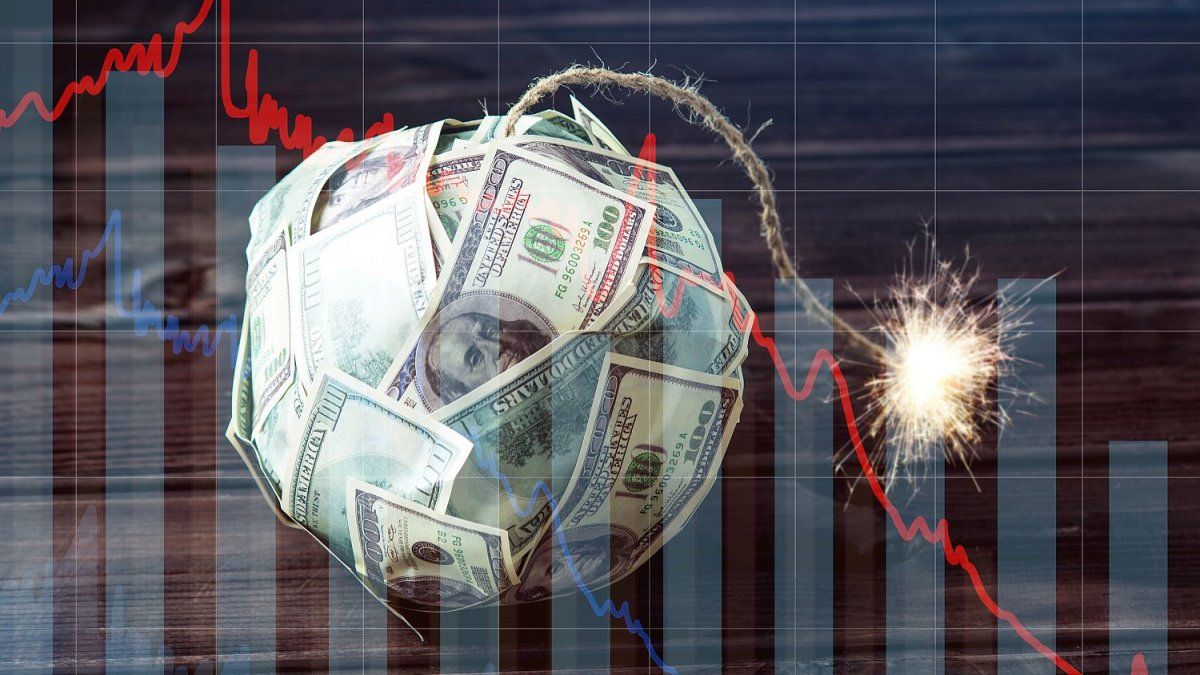In his electoral platform, the presidential candidate of La Libertad Avanza Javier Milei He proposed “immediately releasing all exchange restrictions.” As we know, this fueled expectations of devaluation of the peso, which was branded as execrable rubbish, taking the counted dollar with settlement (CCL) from $536 at the end of July 2023 to $702 when Milei won the PASO.
Exchange rate pressure continued to increase, touching the CCL to a high of $1,110 before the October elections. As Milei’s victory was not 100% certain, after the first electoral round, the CCL fell to $876 in the run-up to the second round on November 19, discounting a more gradual exchange rate unification and, therefore, a lower devaluation at the end of 2023.
When Milei’s victory was confirmed, The market was preparing for a devaluation and dollarization, but the President-elect sent a clear signal that dollarization would not be imminent and that the exit from the stocks (devaluation) would be after solving the issue of the Leliqs and thus the CCL returned to go down in December.
THE CCL rose again in January from $887 to $1,300, given that the market expected a devaluation in March, within the framework of a “shock” policy and an agreement with the IMF, which liberalizes the exchange rate policy with a high dollar to stimulate the liquidation of agriculture.
The need has the face of a herectic
Milei is strategically dogmatic but has shown to be tactically pragmatic. Apart from high-sounding panegyrics in speeches and events, talking about freedom, in the last two months there was a “pragmatic” turn.
The conversations with supermarkets, the regulation of prepaid companies, the managed floating of the exchange rate, the postponement of rate increases, the compulsive payment in bonuses to energy generators, the maintenance of schedules in import payments and various etc.. And after the mini-crisis, openly intervened in the implicit dollarsso as not to stray too far from “when we came from Spain”, a popular saying that refers to immigrant poverty that links to the virulent trip of the President (End?)
Clearly beyond the ideological, to govern and maintain political capital you have to use the necessary instruments whether you like it or not. Like the advertising of its admired former president “Milei did it.”
The run-up to the mini-fight: Minister Caputo reinforces Baglini’s theorem and the heresy
Thus the end of the stocks goes from March to June, then to the second semester, at the end of the year or until sometime in 2024. The President knows, beyond what he says, that the dollar is not balanced without the stocks. Because if it were, the trap would already be eliminated.
To eliminate the restrictions, without a devaluation, reserves are needed – which until now have not been obtained either from the IMF or the capital market or from privatizations or the large investment regime (RIGI) – to face the expected demand for foreign currency, unresolved the stocks of imports and profits with Bopreal, beyond the fact that a new import debt was generated in 2024. An imperfect approximation to a dollar without stocks are the $ 1,300-1,360 of the Bopreal tenders.
Although the President moved away for a moment from Baglini and the heresy, pointing out that no one was enlightened to have the arrogance to establish equilibrium values for the dollar, these months showed various pragmatic heresies.
Thus, beyond analyzing what Milei says, it is interesting to follow what Luis Caputo does.
From the point of view, Caputo’s Baglini plus implies his four postulates to open the trap. It is not only necessary to “fix the Leliq” but the fiscal policy, which has been relaxing and sincere, must be consolidated, finish normalizing the stocks of imports and profits and, as we said, obtain the reserves.
Caputo’s heresy is not new. Abjuring Macri’s original sin of opening exchange regulations suddenly without a consistent comprehensive plan, he abandoned free floating in 2018 and intervened “asking for forgiveness and not permission.” The IMF and some investors were not very happy.
Thus the minister maintained the managed float of 2% beyond February and March, with a CCL that fell again in February and stabilized in March and April and accelerated the drop in the interest rate. The latest rate cut within the framework of estimating core inflation below 5% made the Central Bank go overboard.
The demand for the execrable pesos was maintained despite the drop in rates, but with an effective monthly rate of 3.3% very close to the 2% devaluation, and with cheap implicit dollars, in addition to negative rates against inflation, it began the dollarization of portfolios.
As always happens, there are several triggers to get the chips out of the casino. The dialectic of greed and fear is modified. The lowering of rates, the fight with Spain that affects relations with the European Union and with several chairs of the IMF, the delay in the Bases law, the weakening of fiscal policy, the changing political objectives, international volatility, etc. etc. In the middle, exporters retain the harvest with the lowest settlement in 9 years until the third week of May and with cheap credit available with negative rates that exporters use to wait for the devaluation.
We had analyzed in the note dated May 5 that the exchange rate was 18% below the average of Alberto Fernández’s administration and 25% compared to the second half of the Macri Government.
The truth is that the implicit exchange rate rose 17% until noon on Thursday the 23rd. The blue dollar with a maximum of $1,300 was devalued by 25%, recovering what was lost in real terms in the last three months.
Milei found an enlightened person who not only commits venial sins by determining the “official” dollar but who incurred last Thursday in the major heresy of intervening in the markets (“18 again,” like the movie), and thus the Government managed to reduce the rise to 13% (CCL) and 17% (blue). The ghosts of the heroes of anarcho-capitalism wander in Luna Park while in Reconquista 266, headquarters of the not demolished Central Bank, they brutally renounced the libertarian catechism.
Perspectives
Minister Francos in the transition had spoken of a reasonable dollar of $600 or $650. At today’s values, said value would be $1,186 or 1,287, which implies a level 33% or 44% higher than the current value.
The current value of the dollar is more similar to that of the end of Massa than to the post-devaluation. Today’s value, taken to December, is 449, closer to Massa’s 366 than the 800 of December 14. In good romance, inflation ate up 78% of the devaluation.
Caputo should explain what sense it made to increase the exchange rate by 118%, instead of the reasonable dollar of Francs. Have more margin? The margin, as we saw, was reduced to 22% due to the inflationary increase generated. With this dynamic of devaluing 2% monthly, inflation in October will eat up all the devaluation and the “equilibrium” dollar will be even higher.
Minister Caputo, like so many Ministers of Economy from different heavenly or infernal forces, tried to calm the markets by pointing out that “devaluing” would not make sense. The presidential spokesperson stated that the exchange rate correction would not impact prices, but food prices rose from almost 0 to 2% weekly in the last week of May.
What can happen with the exchange rate. Can it turn out well?
As long as the stocks continue, the Government can maintain the 2% devaluation this year, deepening the exchange rate delay. This week’s exchange rate correction aligned the implicit dollars, but sooner rather than later they will follow the inflation rate, whose floor hardly penetrates 4% monthly.
The prospects for opening the stocks depend on the Government being able to approve the Bases law and an agreement with the IMF.
This is necessary to access new disbursements from the IMF and return to the capital markets (with a probable improvement in the risk rating if said objectives are achieved) to strengthen reserves.
The Government could thus open the stocks with a devaluation of between 25% and 50%, which will depend on the disbursements to be obtained and accumulated inflation. This is how we will experience the return of “carry trade”, benefited by an initial period where funds would enter mining and energy.
In the short term it may turn out “well”, financially and with lower inflation, apart from the worsening of the situation of the real economy and the social situation) if the Government’s agenda progresses and if an external shock does not occur. Initially, the “Dutch disease” can deepen, a temporary appreciation of the exchange rate linked to short-term income.
But experience indicates that monetary artifices, indebtedness and the income of foreign currency through privatizations, concessions or royalties, can be reversed, generating exchange pressure if the economic model is a primary-exporter of an extractive base. Especially if a RIGI is approved in the Bases law that not only does not require the entry of foreign currency from the third year, but also promotes greater imports associated with the investment regime and advances with economic liberalization, which as we analyze in various notes is the opposite. of the world.
The Government’s scheme thus does not ensure a balance in the external sector in the medium term, which requires a high dollar (much higher the greater the openness) and high commodity prices and low international rates to be sustainable. As our history teaches, without reasonable policies it will undoubtedly go wrong in the medium term.
The only way to avoid an external crisis is to implement a model of rational exploitation of natural resources, with industrialization and added value, protecting the internal market. Real heresies that the world is implementing and that Milei “does not see.”
At some point reality will force the Government of the day to return to Baglini and integral heresies, not necessary partial ones, beyond speeches. Not seeing reality, fighting with the world, avoiding internal consensus and underestimating the real economy and the people, can cause the fuses to not only be ministers.
Source: Ambito
David William is a talented author who has made a name for himself in the world of writing. He is a professional author who writes on a wide range of topics, from general interest to opinion news. David is currently working as a writer at 24 hours worlds where he brings his unique perspective and in-depth research to his articles, making them both informative and engaging.




